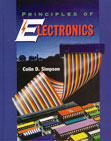
Principles of Electronics
Encyclopedia

Electronics Technician distance education program
The Electronics Technician Distance Education program provides flexible, skills-based training in electronics. It has been developed for adult learners pursuing electronics technician-level training through independent study, specifically students who cannot attend college full-time because of...
and contains a concise and practical overview of the basic principles, theorems, circuit behavior and problem-solving procedures of Electronic circuits and devices. The textbook
Textbook
A textbook or coursebook is a manual of instruction in any branch of study. Textbooks are produced according to the demands of educational institutions...
reinforces concepts with practical "real-world" applications as well as mathematical solution, allowing readers to more easily relate the academic to the actual.
Principles of Electronics presents a broad spectrum of topics, such as atomic structure, Kirchhoff's laws, energy
Energy
In physics, energy is an indirectly observed quantity. It is often understood as the ability a physical system has to do work on other physical systems...
, power
Electric power
Electric power is the rate at which electric energy is transferred by an electric circuit. The SI unit of power is the watt.-Circuits:Electric power, like mechanical power, is represented by the letter P in electrical equations...
, introductory circuit analysis techniques, Thevenin's theorem
Thévenin's theorem
In circuit theory, Thévenin's theorem for linear electrical networks states that any combination of voltage sources, current sources, and resistors with two terminals is electrically equivalent to a single voltage source V and a single series resistor R. For single frequency AC systems the theorem...
, the maximum power transfer theorem, electric circuit analysis, magnetism
Magnetism
Magnetism is a property of materials that respond at an atomic or subatomic level to an applied magnetic field. Ferromagnetism is the strongest and most familiar type of magnetism. It is responsible for the behavior of permanent magnets, which produce their own persistent magnetic fields, as well...
, resonance
Resonance
In physics, resonance is the tendency of a system to oscillate at a greater amplitude at some frequencies than at others. These are known as the system's resonant frequencies...
, control relays, relay logic
Relay logic
Relay logic is a method of controlling industrial electronic circuits by using relays and contacts.-Ladder logic:The schematic diagrams for relay logic circuits are often called line diagrams, because the inputs and outputs are essentially drawn in a series of lines...
, semiconductor diodes, electron current flow, and much more. Smoothly integrates the flow of material in a nonmathematical format without sacrificing depth of coverage or accuracy to help readers grasp more complex concepts and gain a more thorough understanding of the principles of electronics. Includes many practical applications, problems and examples emphasizing troubleshooting
Troubleshooting
Troubleshooting is a form of problem solving, often applied to repair failed products or processes. It is a logical, systematic search for the source of a problem so that it can be solved, and so the product or process can be made operational again. Troubleshooting is needed to develop and...
, design, and safety to provide a solid foundation in the field of electronics.
Assuming that readers have a basic understanding of algebra
Algebra
Algebra is the branch of mathematics concerning the study of the rules of operations and relations, and the constructions and concepts arising from them, including terms, polynomials, equations and algebraic structures...
and trigonometry
Trigonometry
Trigonometry is a branch of mathematics that studies triangles and the relationships between their sides and the angles between these sides. Trigonometry defines the trigonometric functions, which describe those relationships and have applicability to cyclical phenomena, such as waves...
, the book provides a thorough treatment of the basic principles, theorems, circuit behavior and problem-solving procedures in modern electronics applications. In one volume, this carefully developed text takes students from basic electricity through dc/ac circuits, semiconductors, operational amplifiers, and digital circuits. The book contains relevant, up-to-date information, giving students the knowledge and problem-solving skills needed to successfully obtain employment in the electronics field.
Combining hundreds of examples and practice exercises with more than 1,000 illustrations and photographs enhances Simpson's delivery of this comprehensive approach to the study of electronics principles. Accompanied by one of the discipline's most extensive ancillary multimedia support packages including hundreds of electronics circuit simulation lab projects using CircuitLogix
CircuitLogix
CircuitLogix is a software electronic circuit simulator which uses PSpice to simulate thousands of electronic devices, models, and circuits. A version of CircuitLogix with fewer models, simulation, and export features is available free of charge to students after registration...
simulation software
Simulation software
Simulation software is based on the process of modeling a real phenomenon with a set of mathematical formulas. It is, essentially, a program that allows the user to observe an operation through simulation without actually performing that operation...
, Principles of Electronics is a useful resource for electronics education.
In addition, it includes features such as:
- Learning objectives that specify the chapters goals.
- Section reviews with answers at the end of each chapter.
- A comprehensive glossaryGlossaryA glossary, also known as an idioticon, vocabulary, or clavis, is an alphabetical list of terms in a particular domain of knowledge with the definitions for those terms...
. - Hundreds of examples and end-of-chapter problems that illustrate fundamental concepts.
- Detailed chapter summaries.
- Practical Applications section which opens each chapter, presenting real-world problems and solutions.
Books
Principles of Electronics, Prentice-Hall, 2002, ISBN 0-9686860-0-1Study Guide to Accompany Principles of Electronics, Prentice-Hall, 2002, ISBN 0-13-034414-1
Lab Manual for Principles of Electronics, Prentice-Hall, 2002, ISBN 0-13-034422-2

